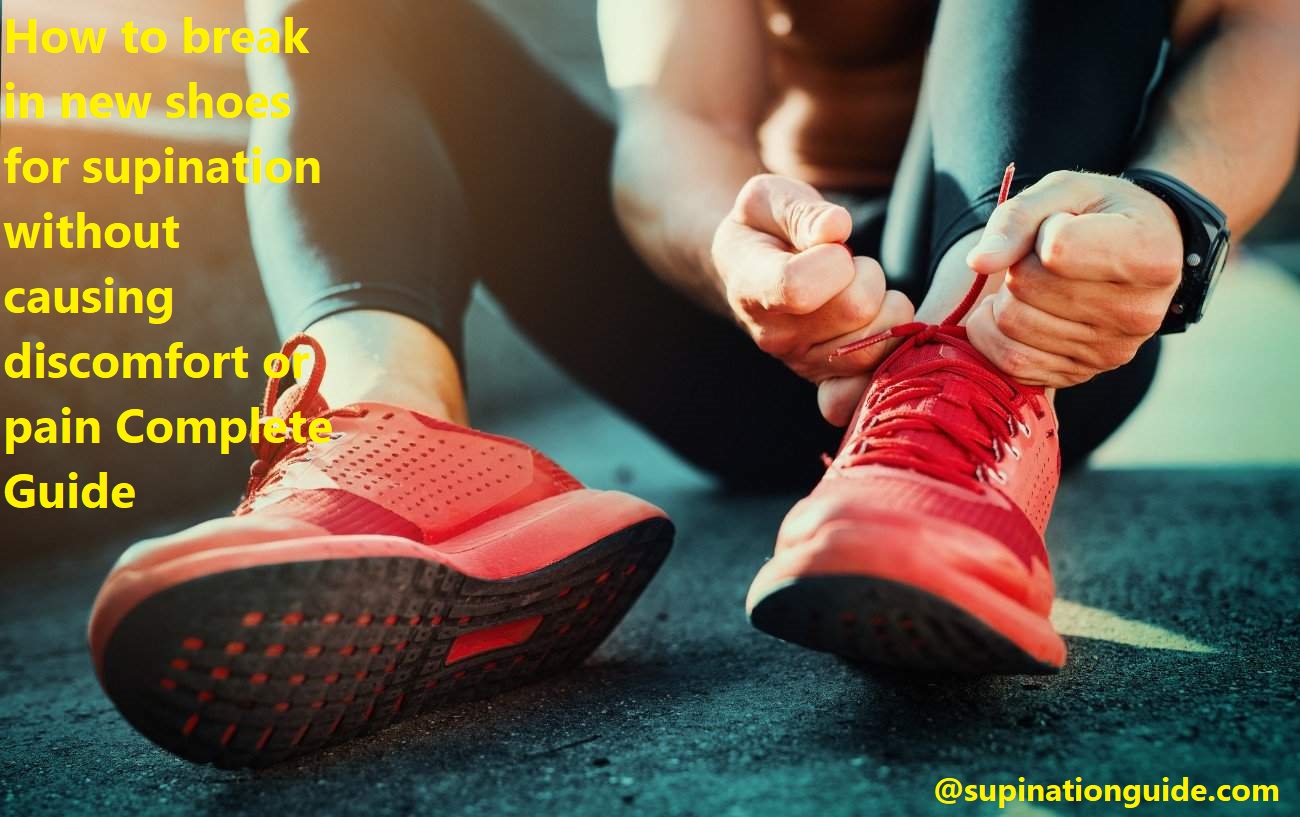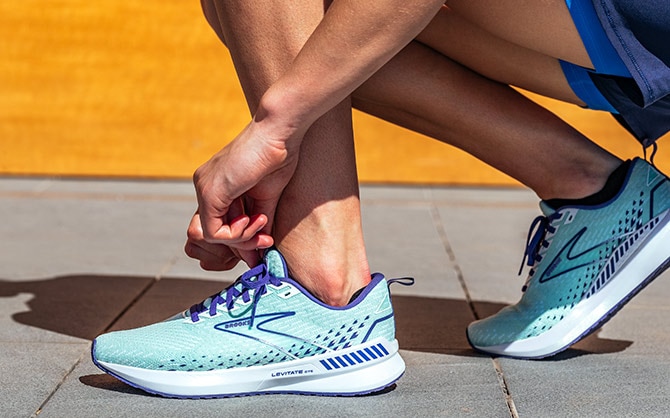Are you worried about the discomfort and pain that comes with breaking in new shoes?
Is your feet’s supination causing additional complications while doing so?
Don’t worry! Here’s a complete guide to help you break in new shoes without any discomfort or pain. You’ll be effortlessly walking around in no time!
Introducing a new pair of shoes with an excessive amount of supination, or rolling inward of the foot, can create issues when attempting to break them in for comfortable use. This can lead to significant discomforting or pain in the feet, ankles, knees and lower back if not addressed properly. Walking with a painful gait for an extended period is not only uncomfortable but can also lead to further lasting bodily harm.
To avoid these problems and ensure proper break-in without serious consequence, it is important to use caution and follow some key steps that will allow for gradual ease-in adaptation. By following this guide you will be able to navigate how to properly break in new shoes while avoiding any pain or discomfort associated with supination of the feet.
Explanation of supination and its effects on shoe comfort
Supination is a foot position where the arch and outer side of the sole are raised higher than usual and is characterized by excessive pressure on the outside of the foot when walking. It can result in a number of issues, including pain and discomfort especially when wearing new shoes. To prevent discomfort from supination, it is important to break in shoes properly to avoid damaging them and allowing your feet to adjust naturally.
Breaking in new shoes for supination takes longer than for normal arched or flat-footed individuals as there are specific areas around the shoe that must be worked on more, such as the heel, arch, inward edge of sole and metatarsal. Start by lacing up your shoes all the way before walking around on them for short periods of time throughout the day. Gradually increase wear time until you’re able to wear them all day without any discomfort whatsoever. Also rotate between different pairs of shoes so as not to overwork any one pair and potentially cause damage over time; this will help ensure your feet healsteadly without injury or pains often associated with wearing uncomfortable footwear. Make sure also you make extra effort too create toe box spacing while wearing them in order too alleviate any pressure from newly formed calluses if necessary.
Remember although it may take several weeks for your shoes to be effectively broken in, doing so reduces potential injuries or damages that may occur if done incorrectly or quickly which could lead to further problems down the line. As such it highly advised that you take a slow approacho breaking into new shoes for supination when possible.

Importance of breaking in new shoes for supination
For people who suffer from supination and the consequent pronation, it is important to break-in a new pair of shoes before using them. Supination occurs when a person’s heel rolls outward more than normal during walking and running, which causes an increased pronation of the foot. This can cause pain, discomfort and even injury if not prevented in time.
Breaking in shoes for supination is an essential part of being comfortable and healthy when wearing them for extended periods of time. The process can be simple, but also requires some patience to ensure the shoe fits properly. Breaking in new shoes takes time but can help prevent strain on your feet that can lead to long-term pain or discomfort.
The primary method of breaking in a new pair of shoes for supination is to wear them around the house while doing chores or casual activities. This allows time for your feet and body to gradually become accustomed to the structure and fit of the shoe with fewer chances of developing blisters or other injuries. It’s also recommended that you insert insoles while breaking in your shoes as they provide extra cushioning and support as well as protection against developing any blisters or sore spots due to excessive friction caused by ill-fitting footwear. The process should not be rushed – it is important to allow your body some time acclimatize the new footwear before heading out on more extended walks or runs.
Choosing the Right Shoes
The first step in breaking in shoes for supination is to choose the right shoes for your needs. If you are a supinator, you will want to look for shoes with a particular set of characteristics that can help make the transition smoother and more comfortable.
When shopping for running shoes, try to find those designed specifically for supination. Shoes designed with this feature tend to be more flexible in the midsole than neutral or stability running shoes. They offer a more natural range of motion while also providing cushion and support. Choosing the right size is also important; be sure to measure your foot before purchasing and opt for a pair that fits properly without being too tight or too loose—any additional room can cause excessive flexing and wear on the outer sole.
For other activities such as walking or hiking, select lightweight shoes made with durable material such as breathable mesh that helps keep your feet cooland comfortable. Look for lace-up styles, which provide additional support and adjustability at ankle level. Additional features such as extra cushioningin the heel or arch support may also be useful depending on your personal needs.
Identifying shoes suitable for supination
If you have supination, or underpronation, it’s important to choose footwear that features the appropriate cushioning and stability. Most sneakers are designed to accommodate normal pronation, meaning they won’t give you the support or cushioning needed for comfortable movement. If you have supination, look for shoes that are specifically designed for “underpronators” or “supinators.”
Highly supportive soles with superior cushioning are key when buying a new pair of shoes if you suffer from supination. The right pair of shoes will also provide flexibility, traction, breathability and additional support that helps reduce strain on your feet as you walk.
Look for multidensity midsoles and shock-absorbing insoles that include additional arch support and heel counters made with strong materials that don’t compress easily during movement. Materials like thermoplastic urethane and polyurethane foam can provide extra cushioning in strategic locations in the sole, such as beneath the heel area for improved shock absorption.
Stiffer outsoles with aggressive grooves will help keep your feet from rolling inward without compromising flexibility in other areas of the sole as well. Look for features like flex grooves below an ankle joint to provide necessary movement without allowing excessive pronation into dangerous levels. The combination of these features should make even lengthy walks feel comfortable and supported with less fatigue overall at the end of your day!
Preparing for the Break-in Process
Before taking on the break-in process, there’s a bit of preparation work that should be done first. Since you know your own shoes better than anyone else, this is your opportunity to get the best out of them. Consider these few things when preparing for the break-in process.
- Check Your Shoes: Before going any further, use a mirror to check your shoes for signs of wear and tear. It’s important to make sure that your footwear is still in good condition before attempting the break-in process. Some common indicators of wear and tear that you should look for include fraying fabrics or loose stitching; cracks, peeling or worn fabric; discoloration; loose soles, etc.
- Determine If The Shoes Are For Everyday Wear Or Special Occasions: Depending on how often you plan to wear your shoes, determine if they are meant for everyday activities or special occasions only (e.g., a wedding). The type of shoe and its purpose should be kept in mind during the entire break-in process since overdoing things could end up causing more harm than good in the long run.
iii. Assess Your Feet: Since they’ll be spending some time with your shoes, it’s important to evaluate how they feel as well as their shape and size beforehand as well as throughout the entire process too – this will give you an idea of whether or not extra measures need to be taken when customizing them (e.g., buying customized footbeds) etc..
iv Take Measurements Of Both Feet: Whether old or new footwear, get accurate measurements of both feet before beginning the break-in process – this can help you properly assess which adjustments will work best on them (e.g., adding foam padding). Knowing exactly what size works best can also help you distinguish between purchasing proper fitting shoes or slightly smaller sizes when choosing new ones too!

The importance of gradual break-in
Breaking in a new pair of shoes that provide support for supination is essential to ensuring they create the perfect fit and achieve the proper level of stability. When you first try on a pair of shoes, they should fit snugly, without causing discomfort or pain. It is important to remember that while shoes can be designed to enhance support and stability, they need time to adjust and conform to your feet.
The key to breaking-in properly is gradualism. Begin by wearing your new shoes for short periods of time (10-15 minutes) with or without short activities such as walking around your house. Then, gradually lengthen the duration that you wear them until you’re comfortable wearing them all day long. The break-in period should last no longer than a few weeks – if your shoes aren’t fitting comfortably after this duration it’s best to start again or consider a different shoe style altogether.
You may experience some mild discomfort during this break-in period due to the movement and pressure put on parts of your foot which are not accustomed to it but do not force yourself because pressure must remain within comfort tolerance levels at all times during the breaking process in order for it to work effectively. If you feel severe pain while wearing your new shoes, be sure to take them off immediately and contact an expert in foot biomechanics who can advise you on whether your newly purchased footwear meets the requirements of optimal support for supination control depending on any underlying medical issues you might have regarding the condition of your feet.
How to prepare your feet for the process
If you suffer from supination, or being overly flat-footed, breaking in your new shoes can be uncomfortable and even painful. To help ease the process, it is important to make sure your feet are well-prepared for the task. Before breaking in your shoes for supination, take some time to first prepare your feet.
The first step is to examine your feet closely for any damaged tissue or structure that could possibly be aggravated by the break-in process. If you notice any issues such as cuts, bruises, blisters, calluses or corns on your feet, that indicates that more foot care is needed before starting the break-in process. It is best to wait until all wounds are fully healed before wearing them again.
The next step is to check if whatever shoes you are wearing are adequately supporting your arch and heel areas respectively. The shoe should have a comfortable arch support that matches the curvature of your foot’s arch and a supportive heel counter to hold the rear foot firmly in place during movement. Make sure these two elements are present before beginning the break-in process for optimal comfort and support of the foot’s structures.
Once all wounds have healed and you’re confident about the fit of your shoe, it’s time to start breaking in those shoes slowly and safely! Begin by wearing them around shorter time periods at first (walking indoors or running errands at home) and gradually increasing their wear over days until they feel truly comfortable on your feet and provided necessary support level with ease. Before long, those newly broken in kicks will get you through even long distance treks!
How to prepare your shoes for the process
When you buy new shoes, especially those designed for supination, it is important to properly prepare them in order to maximize comfort and ensure the shoe fits snugly and securely. Even if your shoes are already broken in, you may need some extra time to help them perform optimally for your particular foot shape.
Before you begin the break-in process, wear thick socks and inspect your entire foot inside the shoe. Check for areas of pressure, too-tight spots, or any uneven lacing – all of which may be remedied with simple adjustments. Then identify any places where seams can chafe against your skin such as ankles, arch area or top of the foot. Areas like these can usually be helped with better fitting socks that are proportionate to different parts of your foot size, independent of a single general sock size.
Test any Velcro straps by fastening and unfastening several times while also wearing thick socks; this will allow you to know how they will feel during actual use as opposed to just testing fit when barefoot. If necessary add a good waterproofing agent or conditioner before engaging in activities that could cause moisture in the shoes from either rain or humidity during use – remember never machine wash leather shoes!
Make sure that heels fit firmly into the shoe avoiding loose spots but not squeezing too tightly; many people forget about heel position when walking due to changing arch shapes over time with age and different activity levels. Lastly adjust laces as needed creating firm support but not overly restricting circulation across entire foot so as not to cause pain or discomfort over time with use.
Conclusion
In conclusion, breaking in your shoes for supination can be a relatively easy process with the right knowledge and tools. Wearing two pairs of socks, using shoe stretching tools, and utilizing creams or oils can help to gradually shape the shoes to your feet. Taking short breaks from wearing the shoes, allowing them to dry out completely before wearing again and avoiding excessive wear in only one area of the shoe can help prevent discomfort or pain.
Following these tips should ultimately help you find a pair of shoes that provides maximum support for your feet and will last you for longer periods of time.

FAQ’s
How do you break in new shoes without it hurting?
- Wear them for short periods of time initially.
- Use shoe stretchers or wear thick socks to stretch them out.
- Apply heat to areas that feel tight.
- Use a shoe stretcher spray or leather conditioner.
- Take breaks and switch to comfortable shoes as needed.
Why do my feet hurt when I break in new shoes?
When you wear new shoes, the material is still stiff and not yet molded to the shape of your feet. This can cause rubbing, blisters, and pressure points that result in discomfort and pain.
How do I stop my new shoes from rubbing?
- Apply moleskin or blister pads to areas that rub.
- Use petroleum jelly or talcum powder to reduce friction.
- Adjust the laces or straps to ensure a secure fit.
- Wear thicker socks to cushion your feet.
How do you break in sneakers so they don’t hurt your heels?
- Choose sneakers with good heel support.
- Gradually increase the time you wear them.
- Use heel pads or insoles for added cushioning.
- Make sure they fit properly and aren’t too tight.
What is the fastest way to break in shoes?
There is no one definitive answer, as the speed of breaking in shoes can depend on the material, style, and your personal comfort level. However, using a shoe stretcher, applying heat or leather conditioner, and wearing them for short periods of time can all help speed up the process.
How do you break out shoes fast?
Similar to breaking in shoes, breaking out shoes quickly can involve wearing them for short periods of time, using a shoe stretcher, or applying heat or leather conditioner to loosen up the material.
How many hours does it take to break in shoes?
The length of time it takes to break in shoes can vary depending on the shoe type and your individual feet. It can take anywhere from a few hours to a few weeks to fully break in shoes.
Does water help break in shoes?
It depends on the material of the shoes. Water can help stretch out leather shoes, but it can also damage suede or other delicate materials. Always check the care instructions before exposing your shoes to water.
What product helps break in shoes?
Shoe stretchers, leather conditioner, and shoe stretching sprays are all products that can help break in shoes.
Does Vaseline help break in shoes?
Yes, applying Vaseline to areas that rub or feel tight can help reduce friction and soften the material, making it easier to break in the shoes.
See Also :
- Best sneakers for supination
- Best asics shoes for supination
- Best tennis shoes for supination
- Best walking shoes for supination
- Best womens running shoes for supination


